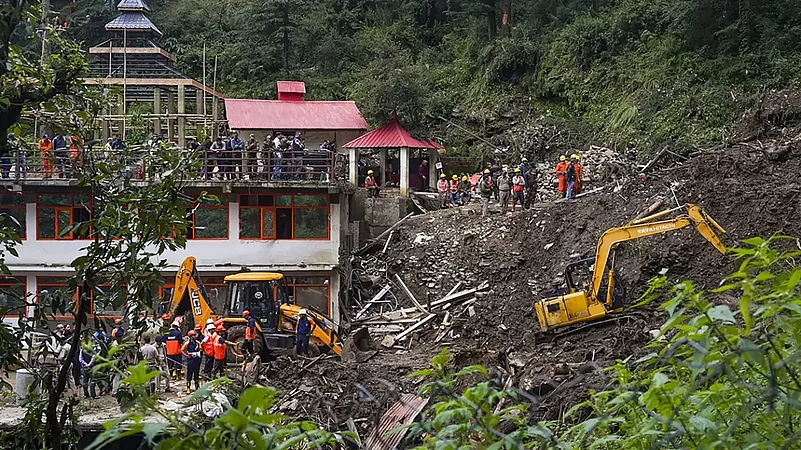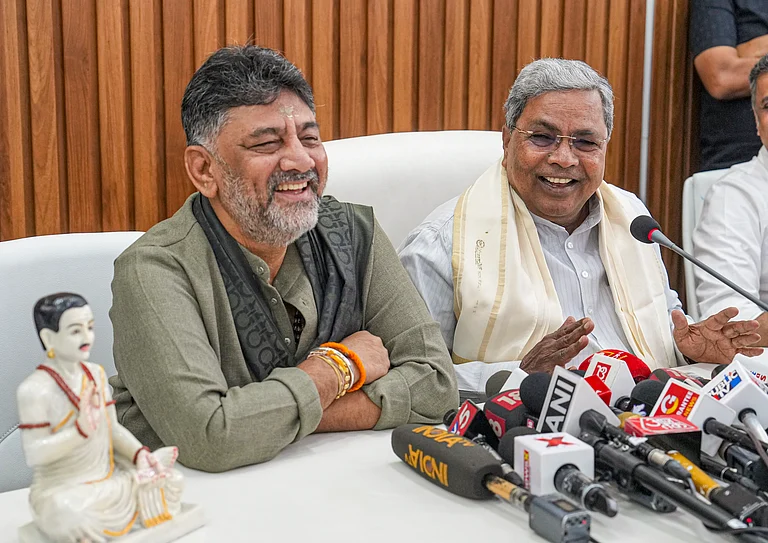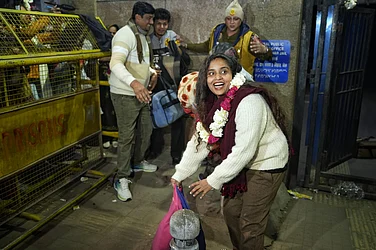Shimla, the summer capital of erstwhile British India, has crossed its carrying capacity by a long shot. The town was built for a population of 30,000 by the British, but it now has a population of around 2.75 lakh.
Himachal Pradesh’s capital Shimla continues to expand both vertically and horizontally. Several iconic landmarks and encroached open spaces of the 150-year-old town are crumbling under the weight of unabated expansion.
There have been repeated warnings about major parts of Shimla —including the iconic Ridge, the only flat space in the middle of the town— slowly sinking and developing wide cracks. The state government has not only failed to put in place an efficient regulatory mechanism on constructions but has also failed to take corrective steps to ease congestion.
The tourism industry also puts pressure on the already-overburdened Shimla. The newly-constructed hotels, homestays, and eating joints in the town and its peripheral areas play a key role in the town’s overburdening. The mobility of the tourists between 20-50,000 along with an almost equal number of vehicles during the peak tourist season adds to the load further stresses the infrastructure and basic amenities which invariably falls short.
Most buildings unsafe, relocate unnecessary buildings: Govt report
Most of the buildings in Shimla are unsafe and are built on slopes not meant for construction, according to an expert committee set up by the National Green Tribunal (NGT).
The committee in its report also recommended relocating any unnecessary government buildings, including those of the Ministry of Defence, outside of Shimla to decongest the town. Several buildings like the Army Training Command (ARTRAC), High Court, Indira Gandhi Medical College Hospital, Indian Institute of Advanced Studies, and Himachal Pradesh University (HPU) are adding to urban congestion in Shimla.
The committee made an in-depth analysis of Shimla’s carrying capacity, population growth trend, constructions, infrastructure growth, civic amenities, tourists inflow, vehicular traffic, and ecological impact in 2017 and warned that an earthquake of high magnitude could cause a severe devastation and could be highly destructive to the town.
Most buildings built on unstable and sinking slopes —which are highly unsafe— will collapse and this could result in significant loss of life difficult to estimate, according to the report.
The committee found that most of the buildings in Shimla are constructed over land with slopes exceeding 45 degrees, and, in certain cases, buildings are constructed on the slopes exceeding 70 degrees. Subsidence of land in a number of areas and landslides are becoming frequent as climate change may act as an amplifier, as per the report.
Shimla requires decongestion, depopulation
The report suggested an urgent need to decongest and depopulate Shimla, particularly areas like Sanjauli, Dhali, Tutu, and Lower Lakkar Bazar. All institutions, including the defense establishments, which are not required to operate from Shimla must be relocated to the plains or other areas, as per the report of the NGT-instituted committee.
“Shimla is sitting on a time-bomb. It has started exploding. The time has come for the government to show a political will to restrict buildings to two-storeys and attic and start dispersal of the office. This will help to restore Shimla’s glory as the most-favoured hill station. Even possibilities can be explored to shift state capital or atleast to move government offices to other places,” says former minister Mohinder Nath Sofat, who held the tourism portfolio in Shanta Kumar government.
Sofat says that the load-bearing capacity of Shimla hills is over-exhausted in the wake of rapid construction activity and is a threat to the fragile Himalayan ecology and mountain ecosystem.
The scale of the infrastructure-growth and requirement of civic services is also alarmingly high in Shimla as it is both a popular tourist town and a state capital. Shimla has been generating nearly 60 to 70 metric tons of solid municipal waste and requires at least 44 MLD of water to meet the town’s requirement. The high-rise buildings —some up to 11 storeys coming-up on steep slopes— and buildings atop traffic tunnels or in the old nullahs (rain water drainage), sinking zones, and landslide-prone areas have always been a matter of concern. The National Institute of Disaster Management (NIDM) has listed Himachal Pradesh and Shimla among country’s landslide hazard locations as part of its zonation atlas on India.
For the past few weeks, the country has seen it play out on their screens. Dozens of houses and several neighbourhoods have been washed away in landslides across the states. In Shimla alone, devastating landslides at three different locations have killed at least 27 in the past two weeks.
Alarmed over massive disasters caused by relentless rains and landslides, the Supreme Court last week decided to constitute an expert committee for carrying out a “complete and comprehensive” study on the carrying capacity of the Himalayan region. The SC said the unplanned development has caused devastation in the hill towns in recent times and it also termed it a “very important issue”.
The carrying capacity is the maximum population size that an ecosystem can sustain without getting degraded, observed a bench headed by Chief Justice DY Chandrachud who was hearing a plea seeking an assessment of the carrying capacity and master plans for the Indian Himalayan Region spanning 13 states and union territories.
When nature’s fury meets systemic flaws
Himachal Chief Minister Sukhvinder Singh Sukhu attributes climtea change as beside human interventions as a key factor of the crises Shimla is facing.
Of total 380 deaths reported in the state, Shimla has reported the highest at 50 — 20 of these at Shiv Bawdi temple landslide where all seven members of a family acriss three generations lost their lives. The landslide was triggered by a cloudburst near Viceregal Lodge,a landmark 135-year-old British era property which now houses the Indian Institute of Advanced Study (IIAS), which is also threatened by the calamity and has shown cracks on the surface. The UNESCO heritage railway line next to it was also seen handing in the air and damaged.
From the onset of monsoon on Jun3 24 to August 21, Himachal received 752.1 mm of rainfall against average rainfall of 730 mm during the whole monsoon season spanning from June to September, according to the Met department.
In 2015, dealing with PIL relating to illegal constructions, the High Court had shown a red flag about possibilities of a massive disaster hitting Shimla if the haphazard and illegal construction were not stopped.
“A high-intensity earthquake can turn Shimla into a rubble grave, as it falls in seismic zone IV and V,” said the High Court at the time.
The bench comprising Justices Rajiv Sharma and Tarlook Chauhan observed that 14 major localities in Shimla are located at 70-80 degree slope whereas the majority of the buildings infringe bylaws and building norms and have not even adhered to the seismic building norms. Sixty per cent of these either fall in the sinking zones or built over blocked drainage channels and traditional water bodies.
Former Additional Chief Secretary (Forest) Avay Shukla in his latest blogpost published a seven-point advisory to CM Sukhu as to how he can save Shimla and Himachal from future calamities.
“Repeal the Shimla Development Plan (SDP) and withdraw the state’s appeal from the Supreme Court against its rejection by the NGT and High Court. This SDP proposes to double Shimla’s population by 2040 and allow construction in the city’s 17 Green Belts, prohibited Core and Heritage Zones, and permit 5+1 floors against against the existing 2+1 in the rest of the city. It is nothing but a suicide note or a death warrant for Shimla and probably the worst policy document ever produced by its government,” said Shukla.
Shukla also called for the government to decongest Shimla and impose a complete ban on all construction in Shimla, Manali, Dharamshala, McLeodganj, Solan, with immediate effect — he even recommended banning the ongoing construction.
Meanwhile, the Sukhu government has set-up a six-member expert committee under Suresh Singh Randhawa, Principal Scientist at HP Council for Science, Technology, and Environment, to study the cause of landslides and undertake an analysis of the land subsistence and landslide activity in Shimla. The committee has been given a week’s time to submit a report which will be forwarded to the state government for action.
Environmentalist Yogendra Mohan Gupta, who has waged a relentless legal battle and has been instrumental in effective interventions of the High Court, NGT, and Supreme Court, says landslides caused by heavy rains must frighten the state government.
“It’s a wake-up call to put a pull stop on all sorts of constructions, stop regularising illegal constructions for ‘vote-bank’ politics and junk Shimla Development Plan,” says Gupta.
The Supreme court has already put the SDP on hold and Gupta continues to oppose it in the Apex Court after the government had filed an appeal against the NGT order of 2017. Gupta says, “The town may collapse like a pack of cards if strong and meaningful remedial steps are not taken to save it. Alas! the government shows the political will.”


























